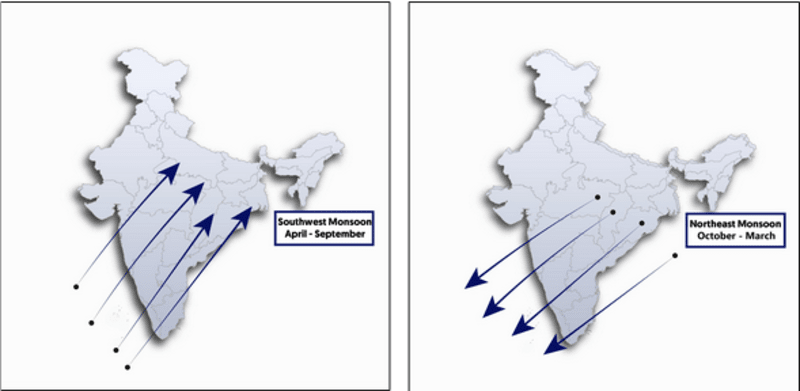Relevance: GS Paper - III
News Excerpt:
The Northeast Monsoon, which brings vital rain to Southern India, experienced its sixth driest October in 123 years, making it the "sixth lowest" since 1901.
About the news:
-
Usually, an El Nino year and positive IOD (Indian Ocean Dipole) mean average rainfall over southern India in October. This year, however, their combined effect has reduced rainfall.
-
Southern India experienced a 60% decrease in rainfall in October due to El Nino and positive IOD, with only 74.9mm of rain received, and the region remained dry for nearly 25 days.
Background:
Indian Monsoons
-
Southern Peninsular India during October sees rainfall from the retreating Southwest monsoon and the incoming Northeast monsoon.
-
Northeast monsoon: The formation of intense pressure over the Siberian and Tibetan Plateaus in the winter gave rise to the Northeast monsoon. Rainfall is attributed to northeastern winds that affect India's southeast coast, i.e. the south shore of Seemandhra and parts of the Tamil Nadu coast.
-
Southwest monsoon: Most of India's areas see considerable rainfall due to the southwest monsoon winds. The intense summer heat on the Tibetan Plateau starts the Southwest monsoon. As a result, low pressure and persistent high pressure developed in the southern Indian Ocean. Large air currents flow through the warm equatorial seas and promote evaporation that leads to the rains brought on by the Southwest monsoon.

Causes of the poor rainfall this time:
-
Genesis of Cyclone Hamoon: Poor rainfall in Southern India was attributed to the formation of Cyclone Hamoon (named by Iran), which coincided with the northeast monsoon, causing moisture to be dragged away from southern peninsular India and altering wind flow patterns.
-
El Nino phenomena: El Nino in the eastern Pacific Ocean is often blamed for erratic monsoon rainfall. Highlighting the uncertainty in weather events, this year's monsoon experienced significant rainfall deficits in particular regions.
-
Climate change: India's monsoon rainfall has been broadly in the normal range for eight consecutive years, with 94% overall rainfall. However, regional and daily variations persist, with significant spatial and temporal variations. Some days experience heavy rainfall, while others stay arid. This variability is increasing, possibly due to climate change.
Analysis by Climate Trends, a research organization:
-
Daily Variations: Out of the nearly 85,000 district rain days — 121 days of rainfall for each of the 718 districts, i.e. only 6% were found to be normal. The districts receiving average daily rainfall are rare.
-
Regional Variations: Rainfall in India varies regionally, with northwest and central regions receiving over 100% rain, while eastern and northeastern regions receive only 80%. The southern region experiences large deficits during the monsoon season but receives 92% rain overall.
Way forward:
-
One of the coping strategies is to become more equipped to handle unforeseen circumstances, i.e. to put more of an emphasis on disaster preparedness. Disaster Management must include all 5 steps to make an actual difference:
-
Prevention
-
Mitigation
-
Preparedness
-
Response
-
Recovery
-
We must take action to eliminate obstacles that worsen the effects of extreme weather occurrences (e.g. Urban Floods).
-
We can enhance climate resilience in new and existing infrastructure by obtaining assistance from the Coalition for Disaster Resilient Infrastructure (CDRI).
-
Drastic actions must be taken to reduce greenhouse gas emissions—known as the primary driver of global warming and climate change—monsoon rainfall is expected to remain unpredictable
Additional information:

PYQ’s
Q1. With reference to 'Indian Ocean Dipole (IOD)' sometimes mentioned in the news while forecasting Indian monsoon, which of the following statements is/are correct?
-
IOD phenomenon is characterised by a difference in sea surface temperature between tropical Western Indian Ocean and tropical Eastern Pacific Ocean.
-
An IOD phenomenon can influence an El Nino's impact on the monsoon.
Select the correct answer using the code given below: (UPSC 2017)
(a) 1 only
(b) 2 only
(c) Both 1 and 2
(d) Neither 1 nor 2
Q2. How far do you agree that the behaviour of the Indian monsoon has been changing due to humanizing landscape? Discuss. (UPSC 2015)
